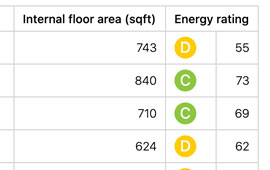The Importance of Price Per Square Foot in Property Investment (Updated 2023)

The property market is constantly changing, and as we enter 2023, it's essential to understand the latest trends and developments. One key factor that has remained consistently important for homebuyers, investors, and real estate professionals is the price per square foot.
In this updated article, we'll explore why the price per square foot matters in 2023, how it affects the value of a property, and what the latest trends and data tell us about the current state of the property market.
Why Price per Square Foot Matters
Price per square foot measures the cost of the property in relation to its size. To calculate the price per square foot, you divide the property's sale price by its total square footage.
For homebuyers and investors, price per square foot is essential when evaluating a property. It allows them to compare properties with different sizes and features and determine the relative value of each.
For real estate professionals, price per square foot is a valuable tool for setting listing prices, assessing market trends, and determining a potential return on investment for a property.
How Price per Square Foot Affects Property Value

The price per square foot can significantly impact the overall value of a property. A higher price per square foot typically indicates that the property is in a desirable area, has high-end features and amenities, or is in a market with high demand and limited inventory.
On the other hand, a lower price per square foot may indicate that the property is in a less desirable area, needs significant repairs or renovations, or is in a market with low demand and abundant inventory.
In either case, understanding the price per square foot can help buyers and investors make informed decisions about the value of a property and its potential for appreciation.
2023 property market Trends and Data
So, what does the latest data tell us about the state of the property market in 2023?
According to recent reports, the property market is still experiencing strong demand, with low inventory levels and rising prices in many areas. Several factors, including low-interest rates, a strong economy, and a growing population, impact this trend.
However, there are signs that the market may be cooling in some areas, as buyers become more hesitant to enter bidding wars and sellers face increased competition from new construction projects.
Despite these fluctuations, price per square foot remains a constant factor in the property market. Whether you're a buyer, seller, or investor, understanding this metric can help you navigate the market and make informed decisions about your real estate investments.
As we enter 2023, the property market continues to evolve and change. However, one constant factor is the importance of price per square foot.
Whether you're looking to buy, sell, or invest in real estate, understanding the value of a property relative to its size is a crucial factor in making informed decisions. You can position yourself for success in this dynamic and ever-changing market by keeping updated on the latest trends and data.
Will building costs go down in 2023 in the UK?

Various factors, including the availability of materials, labour costs, government policies and regulations, and overall economic conditions, can influence building costs. Changes in these factors could lead to rising or falling building costs in 2023.
Our construction cost data is updated at least once a year, and broken down by region and project type.
How much does a house cost per square foot in the UK in 2023?
The cost of a house per square foot in the UK can vary widely depending on location, size, condition, and property type. The average house price per square foot in the UK is around £325, but in London this can easily climb to £800 or more in the most premium areas.
Use our Local Data tool to quickly determine asking and sold price £/sqft in any area around the UK.
PropertyData can always help you make informed decisions about buying or selling property and keep you up-to-date with the latest developments in the property market.



